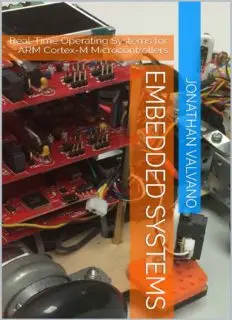Table Of ContentE M B E D D E D S Y S T E M S :
REALTIME OPERATING
SYSTEMS FOR ARM CORTEX-M
MICROCONTROLLERS Volume 3
Fourth Edition,
January 2017
Jonathan W. Valvano
Fourth edition
January 2017
ARM and uVision are registered trademarks of ARM Limited.
Cortex and Keil are trademarks of ARM Limited.
Stellaris and Tiva are registered trademarks Texas Instruments.
Code Composer Studio is a trademark of Texas Instruments.
All other product or service names mentioned herein are the trademarks of their
respective owners.
In order to reduce costs, this college textbook has been self-published.
For more information about my classes, my research, and my books,
see http://users.ece.utexas.edu/~valvano/
For corrections and comments, please contact me at:
[email protected]. Please cite this book as: J. W. Valvano,
Embedded Systems: RealTime Operating Systems for
ARM ® Cortex � -M Microcontrollers, Volume 3,
http://users.ece.utexas.edu/~valvano/, ISBN: 978-1466468863.
Copyright © 2017 Jonathan W. Valvano
All rights reserved. No part of this work covered by the copyright
herein may be reproduced, transmitted, stored, or used in any form or
by any means graphic, electronic, or mechanical, including but not
limited to photocopying, recording, scanning, digitizing, taping, web
distribution, information networks, or information storage and
retrieval, except as permitted under Section 107 or 108 of the 1976
United States Copyright Act, without the prior written permission of
the publisher.
ISBN-13: 978-1466468863
ISBN-10: 1466468866
Table of Contents
Preface to The Fourth Edition
Preface to Volume 3
Acknowledgements
1. Computer Architecture
1.1. Introduction to RealTime Operating Systems
1.1.1. Real-time operating systems
1.1.2. Embedded Systems
1.2. Computer Architecture
1.2.1. Computers, processors, and microcontrollers
1.2.2. Memory
1.3. Cortex-M Processor Architecture
1.3.1. Registers
1.3.2. Stack
1.3.3. Operating modes
1.3.4. Reset
1.3.5. Clock system
1.4. Texas Instruments Cortex-M Microcontrollers
1.4.1. Introduction to I/O
1.4.2. Texas Instruments TM4C123 LaunchPad I/O pins
1.4.3. Texas Instruments TM4C1294 Connected
LaunchPad I/O pins
1.4.4. Texas Instruments MSP432 LaunchPad I/O pins
1.4.5. Interfacing to a LaunchPad
1.5. ARM Cortex-M Assembly Language
1.5.1. Syntax
1.5.2. Addressing modes and operands
1.5.3. List of twelve instructions
1.5.4. Accessing memory
1.5.5. Functions
1.5.6. ARM Cortex Microcontroller Software Interface
Standard
1.5.7. Conditional execution
1.5.8. Stack usage
1.5.9. Floating-point math
1.5.10. Keil assembler directives
1.6. Pointers in C
1.6.1. Pointers
1.6.2. Arrays
1.6.3. Linked lists
1.7. Memory Management
1.7.1. Use of the heap
1.7.2. Simple fixed-size heap
1.7.3. Memory manager: malloc and free
1.8. Introduction to debugging
1.9. Exercises
2. Microcontroller Input/Output
2.1. Parallel I/O
2.1.1. TM4C I/O programming
2.1.2. MSP432 I/O programming
2.2. Interrupts
2.2.1. NVIC
2.2.2. SysTick periodic interrupts
2.2.3. Periodic timer interrupts
2.2.4. Critical sections
2.2.5. Executing periodic tasks
2.2.6. Software interrupts
2.3. First in First Out (FIFO) Queues
2.4. Edge-triggered Interrupts
2.4.1. Edge-triggered interrupts on the TM4C123
2.4.2. Edge-triggered Interrupts on the MSP432
2.5. UART Interface
2.5.1. Transmitting in asynchronous mode
2.5.2. Receiving in asynchronous mode
2.5.3. Interrupt-driven UART on the TM4C123
2.5.4. Interrupt-driven UART on the MSP432
2.6. Synchronous Transmission and Receiving using the SSI
2.7. Input Capture or Input Edge Time Mode
2.7.1. Basic principles
2.7.2. Period measurement on the TM4C123
2.7.3. Period measurement on the MSP432
2.7.4. Pulse width measurement
2.7.5. Ultrasonic distance measurement
2.8. Pulse Width Modulation
2.8.1. Pulse width modulation on the TM4C123
2.8.2. Pulse width modulation on the MSP432
2.9. Analog Output
2.10. Analog Input
2.10.1. ADC Parameters
2.10.2. Internal ADC on TM4C
2.10.3. Internal ADC on MSP432
2.10.4. IR distance measurement
2.11. OS Considerations for I/O Devices
2.11.1 Board Support Package
2.11.2 Path Expression
2.12. Debugging
2.12.1. Functional Debugging
2.12.2. Performance Debugging (FFT analysis)
2.12.3. Debugging heartbeat
2.12.4. Profiling
2.13. Exercises
3. Thread Management
3.1. Introduction to RTOS
3.1.1. Motivation
3.1.2. Parallel, distributed and concurrent programming
3.1.3. Introduction to threads
3.1.4. States of a main thread
3.1.5. Real-time systems
3.1.6. Producer/Consumer problem using a mailbox
3.1.7. Scheduler
3.2. Function pointers
3.3. Thread Management
3.3.1. Two types of threads
3.3.2. Thread Control Block (TCB)
3.3.3. Creation of threads
3.3.4. Launching the OS
3.3.5. Switching threads
3.3.6. Profiling the OS
3.3.7. Linking assembly to C
3.3.8. Periodic tasks
3.4. Semaphores
3.5. Thread Synchronization
3.5.1. Resource sharing, nonreentrant code or mutual
exclusion
3.5.2. Condition variable
3.5.3. Thread communication between two threads using a
mailbox
3.6. Process Management
3.7. Dynamic loading and linking
3.8. Exercises
4. Time Management
4.1. Cooperation
4.1.1. Spinlock semaphore implementation with
cooperation
4.1.2. Cooperative Scheduler
4.2. Blocking semaphores
4.2.1. The need for blocking
4.2.2. The blocked state
4.2.3. Implementation
4.2.4. Thread rendezvous
4.3. First In First Out Queue
4.3.1. Producer/Consumer problem using a FIFO
4.3.2. Little’s Theorem
4.3.3. FIFO implementation
4.3.4. Three-semaphore FIFO implementation
4.3.5. Two-semaphore FIFO implementation
4.3.6. One-semaphore FIFO implementation
4.3.7. Kahn Process Networks
4.4. Thread sleeping
4.5. Deadlocks
4.6. Monitors
4.7. Fixed Scheduling
4.8. Exercises
5. Real-time Systems
5.1. Data Acquisition Systems
5.1.1. Approach
5.1.2. Performance Metrics
5.1.3. Audio Input/Output
5.2. Priority scheduler
5.2.1. Implementation
5.2.2. Multi-level Feedback Queue
5.2.3. Starvation and aging
5.2.4. Priority inversion and inheritance on Mars
Pathfinder
5.3. Debouncing a switch
5.3.1. Approach to debouncing
5.3.2. Debouncing a switch on TM4C123
5.3.3. Debouncing a switch on MSP432
5.4. Running event threads as high priority main threads
5.5. Available RTOS
5.5.1. Micrium uC/OS-II
5.5.2. Texas Instruments RTOS
5.5.3. ARM RTX RealTime Operating System
5.5.4. FreeRTOS
5.5.5. Other Real Time Operating Systems

